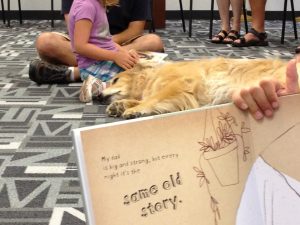Fox Valley group provides comfort in trauma with therapy dogs
By Erika Wurst For Chronicle Media — June 13, 2019
Besides offering comfort, the dogs with Fox Valley Therapy Dog Club are also trained to help teach life skills, such dog care to young children. They provide a sense of emotional well-being and distraction, and put smiles on faces. (Photo courtesy of FVTDC)
When Holy Angels school in Aurora went on lockdown following the Henry Pratt shooting in February, Ed Carter and his team from the Fox Valley Therapy Dog Club jumped into action.
In an attempt to calm students, bring them back to reality and provide comfort, Carter and his team of dogs and handlers cruised the halls and classrooms Holy Angels looking to make a difference.
While roaming the halls and popping in and out of classrooms, the dogs of the FVTDC brought unexpected smiles to the faces of children who were facing some of the scariest moments of their lives.
“That’s what makes this work the absolute best,” said Carter, FVTDC information chair, describing the benefits of his work with the club.
In hospitals, libraries, nursing homes and rehabilitation facilities, it’s not uncommon these days to see Carter and his teams of dogs and handlers showing up to make a difference.
While 16 years ago, when he began working with the FVTDC, the use of therapy dogs was lesser known. These days the trend has caught on and the power of pet therapy is being appreciated across the Fox Valley.
The group works with facilities in Aurora, Montgomery, Oswego, Yorkville, Sandwich and Elgin, working to provide stress relief and comfort to patients in hospitals, brining patients in touch with reality, satisfying their need for touch, and providing relief to families who are struggling with terminal illness.
“A lot of hospital patients will tell you they didn’t expect to see a dog by their bedside, but they really enjoy it. There are many stories I can tell where we touch people and we know it,” said Carter.
Whether it’s the heroic nurse, who just needed a snuggle after a long night, or a woman who is missing the companionship of her own animals during her hospital stay, the dogs bring support and comfort to those struggling throughout the region.
In libraries, programs have been created to allow children to come in and read with the animals a couple times a month.
It’s proven to be a great incentive to get kids to want to come out and read. Carter said that over the years he’s seen the improvement in children’s reading skills as they continue to show up time and time again for Read with Paws events.
“This particular boy just wanted to come in and see the dogs, but we’ve really seen his reading improve, and that’s a good thing,” he said.
Those working with physical therapists utilize the dogs’ companionship by brushing the animals and playing fetch. Children in schools who are dealing with the aftermath of a suicide or traumatic event also find relief in the animals.
Besides offering comfort, the dogs are also trained to help teach life skills, such as bite prevention and dog care to young children. They provide a sense of emotional well-being and distraction, and put smiles on faces.
“There’s no limitation on breeds,” Carter said, explaining that the FVTDC has members with “small dogs, large dogs, and every breed in between.”
The dogs go through intensive training to make sure they’re ready for whatever environment they’re thrown into, and to make sure they are the right fit.
The dogs are still dogs; Carter’s small dog runs wildly around the yard at home and will bark at passersby, but once he steps foot into a hospital, the pup knows he’s working and puts his learned therapy skills to the test.
“We can only do so much training, the dogs really have to pick things up on their own,” he explained, and most times, the dogs certainly do. They instinctively know who is struggling and who needs help. They offer up support in ways humans can’t.
They may be dressed in costume, or perform tricks for smiles, but their reason for being in any facility they enter is to provide comfort and relief to those in need. The idea has come a long way in the 16 years since Carter began his FVTDC journey.
“Sixteen years ago, you had to explain what you were doing. No one knew what a therapy dog was,” Carter said. “These days, a lot more people know we exist.”
And, with a team of 33 dogs and handlers, there’s plenty of animals to go around.
“We want to let people know we’re here and that we’re here to help,” he said.
For more information, visit the web site at http://fvtherapydogs.org/.



